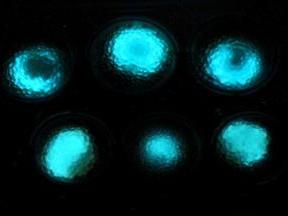Intel and Fred Hutchinson Cancer Research Center to Explore the Use of Nanotechnology Tools for Early Disease Detection
The Intel Raman Bioanalyzer System(TM) to Help Researchers Understand the Molecular Differences Between Healthy Cells and Diseased Cells for Better Diagnostic Methods
Intel Corporation and the Fred Hutchinson Cancer Research Center announced a collaborative research effort to apply Intel's expertise in nanotechnology to develop improved methods of studying, diagnosing and preventing cancer. The announcement was made at the BioSilico Seminar, held at Stanford University.
"To launch the effort, Intel is building an Intel Raman Bioanalyzer System at the Fred Hutchinson Cancer Research Center in Seattle," said Andrew Berlin, lead researcher, Intel's Precision Biology program. "The instrument beams lasers onto tiny medical samples, such as blood serum, to create images that reveal the chemical structure of molecules. The goal is to determine if this technology, previously used to detect microscopic imperfections on silicon chips, can also detect subtle traces of disease."
"This collaboration is a unique and exciting interaction," said Dr. Lee Hartwell, Nobel Laureate and center president and director. "Biologists have never before had such a method for studying the molecular structure of biology. This is true discovery-based research; we don't know what we will see or learn. It may lead to a new era of molecular diagnostics and improved methods of early disease detection."
"Intel enthusiastically endorses Dr. Hartwell's vision of Early Disease Detection and I am thrilled to have this opportunity to help accelerate progress towards it realization. This is collaborative research at its best. Together we can learn how best to adapt advances in nanotechnology to solve some of the most pressing problems in medicine and biology," said David Tennenhouse, vice president, Intel's Corporate Technology Group and director of research.
The Intel Raman Bioanalyzer System is based on a technique known as Raman spectroscopy Intel uses this technique to analyze subtle chemical compositions during the chip fabrication process. By shining a laser beam at an object, molecules within the substance are stimulated to give off a spectrum that can be detected by sensors in a Raman spectrometer. Because every substance has a unique chemical composition, every substance produces a unique Raman spectrum -- the equivalent of a chemical barcode tag.
At the Fred Hutchinson Cancer Research Center, medical researchers hope the specially designed instrument -- the most sensitive of its kind in the world -- will help them identify proteins in human blood serum that foretell the susceptibility, presence or prognosis of diseases such as cancer. At the same time, Intel will learn from them about potential applications and benefits of the technology.
Intel's Precision Biology Program
Precision Biology is a research team of chemists, engineers, biologists and physicists. They combine expertise in microbiology and molecular analysis with Intel's core expertise in microelectronics, MEMS and nanotechnology. The team is conducting long-range research to create fundamental advances in sensor technology, and to work together with the medical community to make it possible to one day use chips to diagnose disease and improve peoples' health.
Other news from the department science
These products might interest you
Most read news
More news from our other portals
See the theme worlds for related content
Topic World Spectroscopy
Investigation with spectroscopy gives us unique insights into the composition and structure of materials. From UV-Vis spectroscopy to infrared and Raman spectroscopy to fluorescence and atomic absorption spectroscopy, spectroscopy offers us a wide range of analytical techniques to precisely characterize substances. Immerse yourself in the fascinating world of spectroscopy!

Topic World Spectroscopy
Investigation with spectroscopy gives us unique insights into the composition and structure of materials. From UV-Vis spectroscopy to infrared and Raman spectroscopy to fluorescence and atomic absorption spectroscopy, spectroscopy offers us a wide range of analytical techniques to precisely characterize substances. Immerse yourself in the fascinating world of spectroscopy!






















































